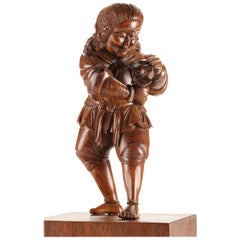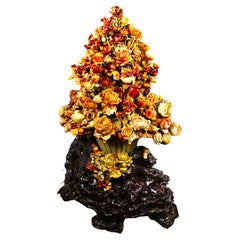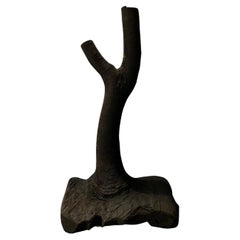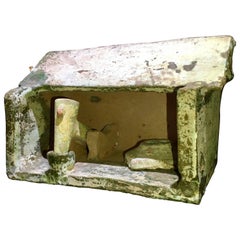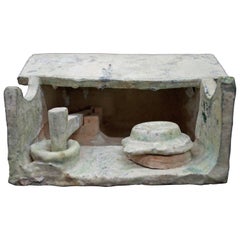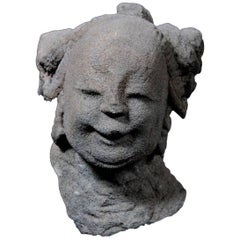East Asian Sculptures and Carvings
to
375
1,126
263
1,584
32
10
20
14
9
8
4
1
1
239
473
872
42
321
193
83
25
2
16
9
7
21
8
12
10
6
691
502
345
229
171
3,312
1,626
1,205
965
781
1,626
1,625
1,625
4
3
3
3
2
Place of Origin: East Asian
Japanese Sculpture Okimono of a Dutchman, Dutch Colonial, 18th Century
Located in Amsterdam, NL
An extremely rare wood Japanese Okimono of a Dutchman playing with a bat
Edo period, 18th-19th century or earlier
The Dutchman is standing and h...
Category
Early 18th Century Edo Antique East Asian Sculptures and Carvings
Materials
Boxwood
Eternal Blossoms: A Chinese Soapstone Masterpiece
Located in Austin, TX
This exquisite large Chinese soapstone sculpture is a testament to the intricate artistry and rich cultural heritage of China. The piece, meticulously carved from a single block of v...
Category
Early 20th Century East Asian Sculptures and Carvings
Materials
Soapstone
$7,350 Sale Price
30% Off
Antique Charred Branch Candle Holder
Located in Asheville, NC
This antique charred wooden branch candle holder is recovered from an old fallen tree. It comes from an old traditional Japanese home with an Irori. An ir...
Category
Late 19th Century Antique East Asian Sculptures and Carvings
Materials
Wood
$700 Sale Price
50% Off
Eastern Han Dynasty Terracotta Model of a Paper Mill , China '206BC - 220AD'
Located in San Pedro Garza Garcia, Nuevo Leon
Slab pottery constructed Model of a Paper Mill, in Green and Cream Color Glazed Terracotta having a peaked roof – open walled form with a mechanical pounder and a large round storage container. Light blue-green mottled glazed surface with some iridescence patina to the glaze. The Iridescence is a refraction of the layers on the glass that produces multicolor hues & metallic luster, and only develops after one thousand years of being buried in the ground. An unquestionable mark of antiquity, impossible to falsify.
Han Dynasty, dated 206 B.C-220 A.D.
Condition: Excellent, wear commensurate with age, an unusual example.
This fantastic piece is accompanied by a Certificate of Authenticity.
Sculptural effigies of domesticated animals were often interred in the tombs of nobility and elite members of the social hierarchy. Models like this one were made to represent everything from simple goat or pig pens to the most elaborate towers and palaces. Because very few ancient Chinese buildings have survived intact, these models, along with descriptions from ancient texts, give a good representation of what the buildings might have looked like.
Burial figurines of graceful dancers, mystical beasts, and everyday objects reveal both how people in early China approached death and how they lived. Since people viewed the afterlife as an extension of worldly life, these figurines, called mingqi, sometimes referred as “spirit utensils” or “vessels of ghosts” disclose details of routine existence and provide insights into belief systems over a thousand-year period. For the first time in Chinese history, we have images of rural and daily life during the Han in the form of contemporary records...
Category
15th Century and Earlier Han Antique East Asian Sculptures and Carvings
Materials
Terracotta
Eastern Han Dynasty Terracotta Barn Workshop, China '206BC - 220AD' Ex-Museum
Located in San Pedro Garza Garcia, Nuevo Leon
Slab pottery constructed barn workshop having a peaked roof – open walled form with a mechanical pounder and a large round covered storage container. Light blue-green mottled glazed surface with some iridescence patina to the glaze.
Condition: Intact, excellent condition, an unusual example.
Provenance: The Living Torah Museum, Brooklyn; ex. Sands of Time, 2002.
Sculptural effigies of domesticated animals were often interred in the tombs of nobility and elite members of the social hierarchy. Models like this one were made to represent everything from simple goat or pig pens to the most elaborate towers and palaces. Because very few ancient Chinese buildings have survived intact, these models, along with descriptions from ancient texts, give a good representation of what the buildings might have looked like.
This fantastic piece is accompanied by a Certificate of Authenticity.
Burial figurines of graceful dancers, mystical beasts, and everyday objects reveal both how people in early China approached death and how they lived. Since people viewed the afterlife as an extension of worldly life, these figurines, called mingqi, sometimes referred as “spirit utensils” or “vessels of ghosts” disclose details of routine existence and provide insights into belief systems over a thousand-year period. For the first time in Chinese history, we have images of rural and daily life during the Han in the form of contemporary...
Category
15th Century and Earlier Han Antique East Asian Sculptures and Carvings
Materials
Terracotta
Ming Dynasty Celestial Deity Head Carved in Stone - China '1368-1644 AD'
Located in San Pedro Garza Garcia, Nuevo Leon
Wonderful celestial deity head with a jovial expression in stone with a finely engraved cap. It is mounted on a custom lucite base.
This piece is accompanied by a Certificate of Authenticity, and Certificate of Expertise by Jean-Yves Nathan - Specialist in Asian Arts for the CEDEA (The European Confederation of Art Experts).
The Ming dynasty was the ruling dynasty of China – then known as the Empire of the Great Ming...
Category
15th Century and Earlier Ming Antique East Asian Sculptures and Carvings
Materials
Stone
Read More
12 Calming Spaces Inspired by Japanese Design
From cherry-blossom-adorned walls paired with glamorous lighting to wood-paneled ceilings above checkerboard-patterned chairs, these 12 spaces seamlessly blend Eastern and Western aesthetics.
Rodrigo Rivero Lake’s Mexico City Showroom Is a Museum-Worthy Trove of Spanish Colonial and Asian Antiques
The dealer and curator has spent the past 50 years amassing a collection of exceptional art, furniture and architectural elements that trace the cultural influence of the Spanish empire from Europe to the Americas and beyond.
Recently Viewed
View AllMore Ways To Browse
Japan Temple Flowers
Japanese Stone Basin
Guan Yin
Korean Temple
Japanese Noh Mask
Indonesian Statue
Jade Ornament
Japanese Bird House
Imperial Stone China
Japanese Iron Box
Large Jade Sculpture
Hindu Statues
Japanese Wood Buddha
Large Carved Buddha Statue
Laughing Buddha
Hindu Gods
Metal Asian Statue
Jade Jadeite Sculpture
